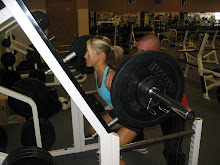I had a friend and previous client ask me a great question the other day. In fact, it's
a question I get a lot - so I've decided to write some thoughts down. Hopefully they make sense and you'll finish reading this with a bit better understanding of this thing we called fitness.


VS.
Q. What is better for weight loss and toning the legs: running on the treadmill or doing the elliptical?
A. ANYTHING that gets your heart rate elevated, major muscles moving for an extended period of time is cardio exercise. You can achieve this through treadmill work, elliptical, stair climber, walking up stairs at home, dancing, running...the list is endless! There really is no "better" exercise (I get that question all the time) - it all depends on what you ENJOY (exercise should be enjoyable!) and what you are able to challenge yourself on.
It's important to consider two things, however: Heart Rate and How Many Muscles are used. The higher your heart rate, the higher the intensity of the exercise and the more calories you will burn per given amt of time. Similarly, the more muscles you use, the more calories you will burn. Ellipticals and running on a treadmill are very similiar in the muscle groups they work...the elliptical, however, is little-to-no impact, so is a bit easier on the joints.
If I think of a recumbant bike vs treadmill - I know that I am seated on a bike (so less muscles used) but if I'm lolly-gaggin' on the treadmill and hardly have my heart rate up, it doesn't matter that a treadmill uses more muscles (you're standing and pumping your arms, so automatically your arms and core/back are working), if my heart rate is hardly up, then the bike would be the better option (considering I'm working hard on the bike).
It is good to spice things up. Always keep the muscles guessing and changing focus - b/c our bodies adapt quickly, if we do the exact same thing each exercise session, it will no longer be overload for the body. You must overload the body for any changes to happen - this can be done by using different muscles or increasing intensity, etc (up the speed, incline, duration, etc).
CARDIO machines primarily increase the health of the heart, lungs and blood vessels. As you raise your heart rate and get your major muscles moving for an extended period of time - and do this consistently - you get more and more 'in shape'. Being conditioned or 'in shape' means that your heart muscle has actually gotten bigger/thicker and stronger, so with every beat, it pumps out more blood (aka oxygen and nutrients) to your cells. This is why your resting heart rate decreases as you get more conditioned - the heart has to work less to get blood to your body. You blood vessel walls get stronger and more resilient, so as the blood rushes through them, there is less liklihood of rupture (stroke) and the plaque that may be built up on the inside of the vessel walls is more likely to be removed (so less clogging of arteries = less chance of heart attack).
Also, in your lungs, there is a more efficient exchange of oxygen (in) and carbon dioxide (out) - which is why it's easier to breathe as you get "in shape". Not only does this gas exchange happen more efficiently in our lungs, but also in the cells of your muscles.
...All this to say...cardio exercise is exercise for the above mentioned things - IT DOESN'T NECESSARILY PROVIDE THE MUSCULAR OVERLOAD TO BE CONSIDERED STRENGTH TRAINING - and therefore, isn't the primary method used to develop muscular changes (ie - TONE). Cardio is necessary for body fat reduction - which will certainly help in noticing tone - but, to get shapely, defined leg muscles, LIFTING WEIGHTS is where it is at!
While consistent cardio exercise does provide an overload that may result in muscle hypertrophy (growth), Your cardio routine, because it may use your legs, is NOT a replacement for leg muscle strengthening and toning!!! Doing leg and hip weight-training exercises will provide the direct muscle OVERLOAD to breakdown the muscle fibers and (with rest and protein) the muscles will be repaired, coming back together stronger and more toned. This, combined with CARDIO and good NUTRITION (SO important in body fat reduction), is the killer-combo for a lean, toned body.
 Trouble Sleeping?
Trouble Sleeping?








 Saturated: Meats, eggs, butter, cheese, palm oil, ice cream, cream cheese, sour cream, etc.
Saturated: Meats, eggs, butter, cheese, palm oil, ice cream, cream cheese, sour cream, etc.

